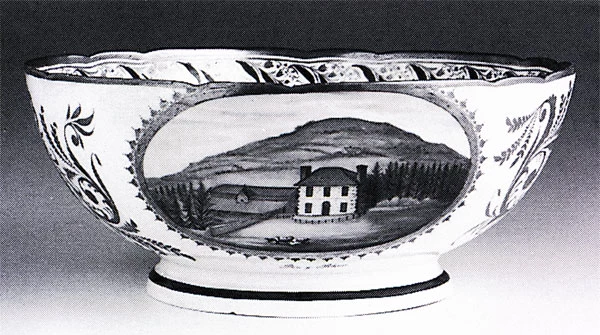Historical records of a forgotten era
Nantgarw porcelain bowl painted with Pen-y-Rhos, 1821-3
Bone china cup painted with the Pentwyn ironworks, c. 1835
Landscape views have long been used to decorate cups, saucers, plates, bowls and jugs. Some have been scenes from the artist's imagination; others have been views of real places. Examples on display at National Museum Cardiff include views of Dolgellau and of the Vale of Neath on Nantgarw porcelain and a painting of Castel Gandolfo in Rome on an early 19th-century dish made at the Imperial Porcelain Factory in St Petersburg, Russia.
The porcelain painter usually worked from an engraving, but they could also work from memory or from an image that no longer survived, making the decorated piece itself a valuable and precise record of somewhere that might otherwise be forgotten.
Pen-Y-Rhos Farmyard, Nantgarw
One such important piece in Amgueddfa Cymru's collection is a large porcelain bowl. On the front of the bowl is an oval framed image of a house and barns flanked by trees, with a hill behind. This is inscribed 'Pen-y-Rhos'. On the back of the bowl is an image of a farmyard with cattle and poultry in the foreground.
Although the bowl doesn't have any identification marks, the paste, the heavy potting and the decoration are all characteristic of Nantgarw. Other evidence includes a fragment from an identical bowl, which was found at the site of the Nantgarw factory. The painter was probably Thomas Pardoe who worked at Nantgarw from 1821 until his death in 1823.
Pen-y-Rhos is a farm one mile from Nantgarw, on the outskirts of Caerphilly. In the early 19th century it was the home of Edward Edmunds. In 1814 he sublet the factory site, a cottage and land next to the Glamorganshire Canal to William Billingsley and Samuel Walker. In 1820 he sublet it again, this time to William Weston Young.
Three complete sets of dishes were thought to have been made at the factory for Edmunds and his family. None of these sets survive complete but they are thought to date from Billingsley's ownership of the pottery in 1817–19.
The Pen-y-Rhos bowl was not part of these sets but is of a later date. It may have been a gift from Young or Pardoe to Edmunds.
So as well as being a key documentary piece of Nantgarw porcelain, the bowl bears a rare view of a Glamorgan farmhouse in the 1820s.
Pentwyn Ironworks, south Wales valleys
If the Pen-y-Rhos bowl reveals a forgotten agricultural view, then this two-handled Staffordshire bone china bowl or cup reveals a forgotten industrial landscape. Dating from around 1835, this piece is decorated on the front with a view of Pentwyn Ironworks within a gilt frame. On the back is the name I Hunt Esq. ('Esq.', short for 'Esquire', was sometimes used in place of 'Mr').
The Pentwyn Ironworks were on the western edge of Abersychan, three miles from Pontypool in the south Wales valleys. The ironworks were established in 1825 and consisted of three blast furnaces built by the Hunt family. By 1839 the works were the property of the Pentwyn Company, but it is not known whether the Hunt family was still involved.
Before 1848 the Pentwyn Company passed to the firm of Williams & Co. and all the buildings were subsequently demolished. The image on this piece, which must have been commissioned for or by one of the Hunt family, is the only known view of this industrial site at that time.

